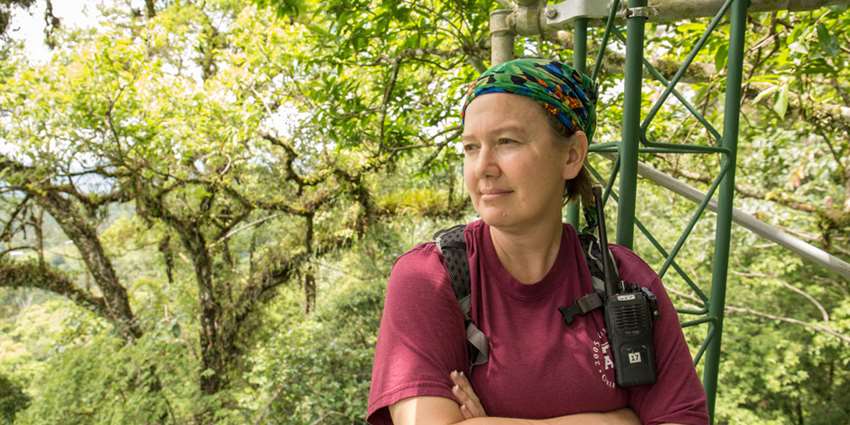Whether it’s on an island off the coast of Georgia, under the canopy of a rainforest in Costa Rica or in the arid Trans-Pecos in West Texas, for Dr. Georgianne Moore, working in the field is where she feels most at home.
Now an associate professor in Texas A&M University’s Department of Ecosystem Science and Management, Moore was raised on a farm in Georgia’s Piedmont region and spent most of her childhood outdoors — a lifestyle she has applied to her current research practices.
“I have for a long time been interested in natural resources,” Moore said. “Working in the field is what keeps me enjoying my work.”
Moore originally enrolled at the Georgia Institute of Technology with the intent to continue on to medical school, but, influenced by several of her professors, became interested in plant ecology and hydrology.
After earning her bachelor’s in applied biology, Moore went to work for the University of Georgia Marine Institute, where she experienced her first taste of research.
“I was responsible for collecting data, maintaining equipment and providing support for a lot of the research that was going on,” she said. “Ever since then I’ve been in love with field stations.”
Moore conducted further research at the H.J. Andrews Experimental Forest ecological research site while attending Oregon State University and received her doctorate in environmental sciences, with an emphasis in small watershed hydrology and forest ecology.
“I stayed on-site for most of summer, living in its dorms, going out in the field every day and spending a lot of time in the forest,” she said. “I worked with older trees that were just majestic.”

Moore’s post-doctoral work with Texas A&M AgriLife Research in ecohydrology — the study of the role of plants in the water cycle — led her to the Pecos desert and Rio Grande in New Mexico and Texas. That dry environment was a stark contrast to her previous research sites in the Pacific Northwest old-growth forests of Douglas fir, cedar and hemlock trees and the rugged terrain of the western Cascade Mountains.
“I didn’t think I would stick around for very long,” Moore said. “But what I enjoy about being in Texas is that Texas has fascinating water resource problems.”
The severe drought in 2011, for instance, prompted Moore and her team to study native Texas trees that died during the drought and understand how and why different species survived. This study further developed into controlled experiments in which seedlings were deliberately exposed to fatal environmental conditions to better explain the deterioration and eventual death of trees.
While water supply is a critical component for most of ecohydrology, Moore’s research in Costa Rica has indicated that tropical environments with abundant rainfall influence plant behavior through a variety of other ecological factors.
“It’s completely different in the tropics,” she said. “There’s plenty of water, and other things are changing how plants behave.”
Two or three times a year, Moore returns to the Soltis Center for Research and Education, Texas A&M’s rainforest field station near the Costa Rican town of San Isidro de Penas Blancas, where she helps lead a major federally funded project and supervises a doctoral student.
Much of the research is conducted on an aluminum walkup tower made of 21 six-foot scaffolding sections that allows the scientists to access various heights for sampling purposes. They collect data using instruments that analyze the microclimate of the forest, such as electronic artificial leaves that estimate the wetness of leaves after rainfall.
The team measures water vapor within the forest and other environmental components that affect evaporation and growth rates of the trees. This could inform global climate models and aid in understanding weather forecasts and climate change.
“A lot of the moisture in the earth’s atmosphere in the whole world is evaporated from oceans and tropical forests,” she said. “[Changes in the tropical forest] will affect the global climate because of the changes in the water vapor in the atmosphere.”
Reflecting on the direction of her research over the years, Moore said her focus has shifted away from location-specific water issues to much broader subjects related to ecosystems, global climate change and drought.
This approach is likely to continue into future research, she said, as apparent in a recently launched project called the Texas Water Observatory.
The observatory will become a network of sites designed to monitor and understand water cycles, beginning in the Brazos Valley and eventually expanding to include different climate gradients of the state, Moore said.
“There are other places in the country where similar networks are in place, but we’re going to be doing this differently,” she said, “a bit more state of the art, and really try to make an impact on water research in Texas that has so far lacked a place to tie it all together.”
The project received short-term funding from the Research Development Fund at Texas A&M, with contributions from the College of Agriculture and Life Sciences, College of Geosciences and Dwight Look College of Engineering. Moore is confident that it will develop into an independently-operated, long-term monitoring network that will pay large dividends and grow into major projects.
For more information on Moore’s work, visit her lab’s website.



